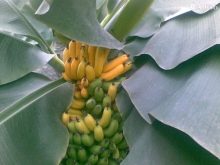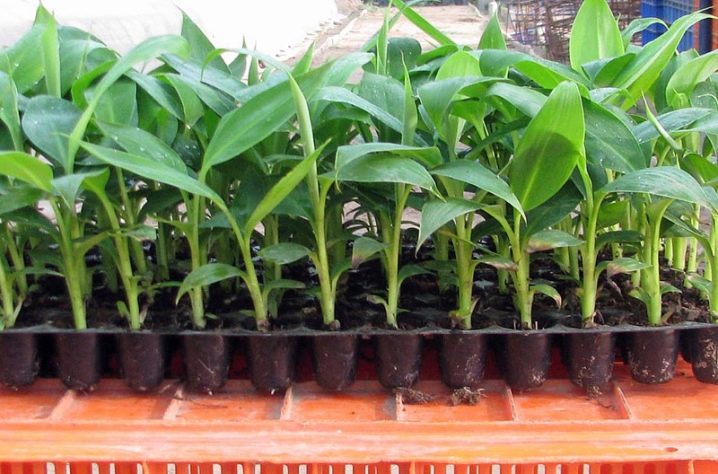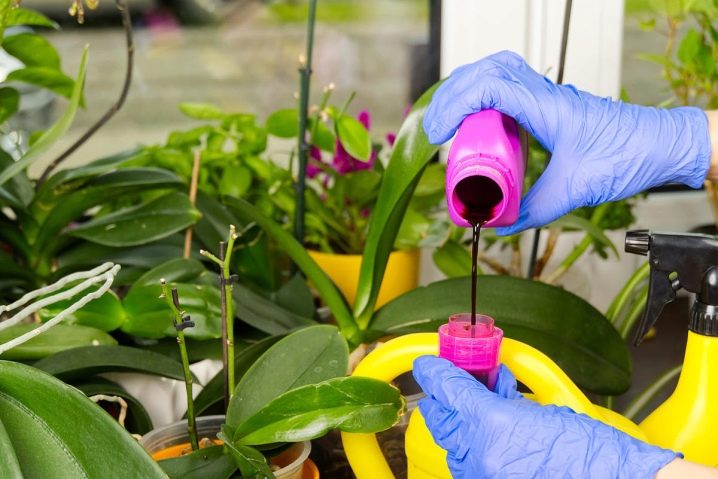How to grow a banana at home?

The ability to grow an exotic plant at home attracts many gardeners and just home flower lovers. And if you manage to get fruits from this tree, then this is quite a dream. Many people try to germinate banana seeds, or root a plant leaf, but more often than not, attempts fail. For a successful result, you need certain knowledge, a lot of effort and time.

Variety selection
In the wild, a banana grows up to 10-12 meters in height. Therefore, at home, it is better to grow a banana dwarf varieties. Such varieties grow up to 2 meters. The most effective and simple way is to divide the rhizome of an already adult plant, or take a root process. In this way, fruiting varieties are most often propagated. Growing from seeds obtained from fruits is considered ineffective and rarely gives a result. Ornamental plants that do not produce fruit often grow from seeds purchased in specialized stores. And if decorative varieties bear fruit, then they are unsuitable for food.

At home, you can grow indoor banana varieties - both fruiting and decorative. The fruiting ones include:
-
Kiev dwarf and superdwarf;
-
The Cavendish is dwarf and super dwarf;
-
Pointed banana.



Among the ornamental banana varieties, the most popular are:
-
Velvety banana;
-
Lavender;
-
Chinese dwarf banana;
-
Bright red banana.



It is very difficult to obtain edible fruits at home. This is possible only with proper plant care and a special microclimate. Flowers of decorative varieties are very beautiful and unusual. Some ornamental varieties produce small fruits after flowering, but they are inedible.

How to germinate seeds?
Banana seeds can be purchased at a specialty store, or you can get your own from store-bought fruits. Getting seeds from the fruit on your own and sprouting them is a rather painstaking task, and may not work. Some exotic plant lovers bring seeds from bananas bought in Southeast Asian countries. They usually have one large black bone.

To obtain seeds from a banana, the fruit must be placed in a plastic bag and wait until it turns completely black. Regular store-bought bananas will not work. You need a banana that is fully ripe on the bush (wild banana), rather than ripening on a shelf or in a drawer. Carefully cut the blackened fruit and remove the pulp with a spoon. In the middle of the pulp are seeds, they are dark brown or black. They need to be washed from the pulp and laid out on a napkin or cloth, dried a little. Clean seeds need to be sorted out. Flat specimens are unsuitable for germination; you need to select round-shaped seeds without visible damage.

Selected seeds are poured with water for 2-3 days and left in a warm place. Then they need to be rinsed again with warm water and dried. The seeds are ready for germination.
Some hobby gardeners skip the seed soak step. After freeing the seeds from the pulp and washing, they carefully lay them out in one row on the prepared strips of napkins or toilet paper. And immediately place them in a tray (container) with prepared soil or substrate. Sprinkle with earth, and watered abundantly.

For planting seeds, an inert substrate is needed; plant fiber (coconut or sphagnum) is suitable. It can be found in specialty stores. You can prepare the soil yourself.To do this, you need to mix sand and peat in a ratio of 3: 1. The substrate must be disinfected before planting, spilled with boiling water, doused with steam or spilled with a weak solution of potassium permanganate. Drainage must be laid out at the bottom of the germination container. Then a layer of substrate in which the seeds are placed is sprinkled with soil on top and watered abundantly.
A container with seeds can be placed on a battery on the east or south-east side of the house (apartment).

Experienced gardeners advise you to scratch the seed coat a little before planting. To do this, you can use a regular needle. Also, the seeds can be rubbed a little with a nail file or fine sandpaper. This will help the sprouts to germinate faster through the hard seed coat. But this must be done with care so as not to damage the core in the center, but only slightly violate the integrity of the upper rough shell.
At first, you can organize a greenhouse for seeds by covering the container with polyethylene. After the sprouts appear, the film must be removed. At the time of germination, it is necessary to maintain the temperature in the room during the day + 28 ... 32 degrees, and at night about +20 degrees. Banana sprouts must be protected from drafts and sudden changes in temperature. Watering should be done regularly, but not overfilled.

Seeds will begin to germinate only in the second month, sometimes it takes longer. During this time, mold may appear on the surface of the substrate. The soil must be shed with potassium permanganate (potassium permanganate solution).

Transplanting a germinated plant
You can transplant a banana sprouted from a seed into a larger pot when the sprout reaches 10 cm in height. The pot is selected based on the expected size of an adult plant. For small dwarf plants up to 50 cm in height, the formula is as follows: for 10 cm of a plant there is 1 liter of a pot. For large plants about 1 meter high - 20 cm of plant per 1 liter of pot.
It is better to buy soil and drainage in the store. The soil needs neutral, with medium acidity. If desired, the soil can be prepared by yourself.

To do this, in ordinary soil (the top layer of soil under a birch, hazel, acacia or linden tree is best suited), you need to add sand, wood ash and humus in proportions of 10: 2: 1: 0.5. The mixture must be ignited. Drainage is laid out on the bottom of the pot (small pebbles are suitable), then a layer of wet sand, and only then the prepared soil (it should be warm). The sprout is deepened 2-3 cm into the soil. This must be done carefully so as not to damage the root system.

A small, freshly transplanted plant is best placed on a south-facing windowsill. There will be enough sunlight for him to grow actively. After the plant grows up and the root system takes up the entire space of the pot, the plant must be planted in a larger container. You can find out about the time of transplantation by the appeared white processes in the drainage holes. The pot for transplanting should be chosen 4-5 cm larger in diameter. You need to transplant a banana using the transshipment method, that is, keeping an earthen lump around the rhizome. So the plant will better tolerate the transplant, and will not hurt.

Care
Growing a banana at home is not an easy task that requires diligence, care and time. Growing a plant, especially a store bought one, requires constant maintenance. Basic plant care consists of:
-
regular watering:
-
loosening the soil;
-
spraying;
-
maintaining the required temperature in the room;
-
ensuring adequate lighting:
-
feeding.

With proper care, the plant begins to grow actively... Decorative banana varieties will begin to bloom after the appearance of 10-12 leaves. The plant can bloom all year round. Fruiting varieties will bear the first fruits for 2-3 years of growth with good care and providing all the necessary conditions. Flowers will have to be pollinated manually. And after fruiting, the shoot will die off - this is a natural process.After a while, a new process will appear in its place or next to it.

At home in a pot, a banana will not grow more than 2 meters, even if it is a regular plant, and not a dwarf... Many people mistakenly think of a banana as a palm or tree. It is actually a herbaceous plant. All we see are the leaves of the plant. Closer to the ground, they fit so tightly to each other that they seem to be a trunk. The root system is spherical and deep in the ground. Processes grow from it, on which leaves are formed, and then flowers and fruits. After fruiting, the shoot dies off, and a new one is formed in its place. The plant can live and bear fruit for up to 40 years. A plant grown at home from seeds is not so capricious.
You need to take care of him, like for another ordinary indoor flower.... For an adult plant, a soil made from a mixture of peat and ordinary earth is suitable. After watering the next day, the soil must be loosened to avoid stagnation of moisture, the banana does not like waterlogging. Banana roots love air, so regular loosening is important to improve air exchange. With waterlogging or stagnant moisture, the leaves begin to turn yellow and wither. If this happens, you need to transplant the plant, and increase the drainage layer. The drainage layer should be 3-10 cm, depending on the volume of the pot.

Temperature and lighting
During active growth, the temperature regime in the room must be observed. Day and night, the temperature should not drop below +23 degrees. Small fluctuations are allowed. But it is worth remembering that at temperatures below +15 degrees, the growth of a banana stops, the plant seems to hibernate, but it may die. At the same time, an increase in temperature above +30 degrees is also undesirable.
Considering the regions where the banana grows in the wild, the place needs to be sunny.
Choose the lightest room or window sill where the sun's rays hit the most and the longest. If there is not enough light in the house, then you need to install additional artificial lighting.

With a lack of light, the banana stops growing, does not bloom and does not bear fruit. If the climate permits, and the temperature does not drop much at night, then in the summer the plant can be taken out into the yard, choosing a sunny place on the site. Or move the pot to the balcony if it faces the sunny side. In this case, it is necessary to avoid direct sunlight on the leaves by fencing off the plant with a thin fabric curtain.

Fertilizers
It is necessary to feed the plant throughout its life. For fertilization, you can use ordinary humus, wood ash or herbal infusions. And also nitrogen fertilizers are used for feeding, but organic fertilizers are preferred. In the spring-summer period, feeding in small portions is applied every 2 weeks, fertilizers are added during watering.
Every six months, the soil in the pot must be spilled with a weak solution of potassium permanganate.

Watering
Banana requires regular, abundant watering. But the water should not stagnate in the pot, good drainage is needed... Waterlogging and stagnant moisture can cause root rot. To accurately determine when to water, be guided by the condition of the soil. When the top layer has dried 1-1.5 cm deep, it's time to water. For irrigation, it is better to use settled running water. The water should be warm, about 25 degrees. Watering is necessary until moisture appears in the pallet.
In winter, it is recommended to reduce the amount of water and the frequency of watering.

The plant also needs to provide indoor humidity of at least 50-60%. To do this, you can use a humidifier, or regularly spray banana leaves. In summer, you need to spray a banana every day, and in winter it will be enough 1-2 times a week. And also you need to periodically wipe the leaves with a damp cloth, removing dust from the leaves.

Diseases and their treatment
Home-grown bananas rarely get sick with proper care.Of the insect pests that attack the banana, the spider mite is the most common. It appears when there is insufficient watering and drying out of the soil. Damages both the root system and the leaves of the plant. When a spider mite appears, first of all, the leaves of a banana turn yellow, then the plant dries up and may die. It is necessary to remove all affected leaves and parts of the plant, water and spray the plant regularly. The remaining leaves should be treated with soapy water and sprayed well with clean water. Insecticides can be used if necessary.

Sometimes you can face rotting of the roots due to excessive stagnation of moisture. This does not happen from over-watering, but because of a poor (insufficient) drainage layer. In this case, the plant needs to be transplanted by increasing the drainage layer and improving the soil composition. And you can also create additional space between the pot and the pallet. Then the air will circulate better.








































































































The comment was sent successfully.